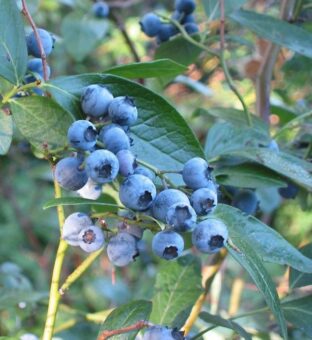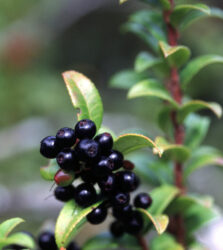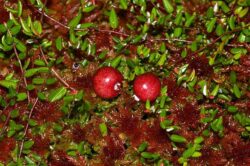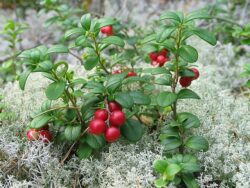In this article, we will discuss how to grow the various members of the Vaccinium family in containers. Vaccinium is a common and widespread genus of shrubs that belongs to the Ericaceae (Heath) family. It is a large family where over 450 species are known to exist, and many of its fruits are edible in species. These include cranberries, blueberries, bilberries, cowberries, lingonberries and many more.
There are generally found growing through the Northern hemisphere but extending far south to the Malesia.

The plant structures vary from species to species where some are dwarf, whilst others grow up to 2m tall. The shrubs can be either erect or creeping with alternate deciduous or evergreen leaves. In spring to summer, urn-like white, white/pink or pink flowers that resemble true heathers appear.
The only difference is that the ovaries of the flower do not occur within the flower but beneath it. The flowers occur singly, in clusters, or on long spikes on the leaf axil. The flowers are followed by red or black berries that are usually edible.
On some species, the leaves will turn vibrant colours of yellows and reds before falling off. In some species, the leaves are retained throughout winter.
Four species are native to the UK and these include Vaccinium myrtillis (Common Bilberry), Vaccinium uliginosum (Bog Bilberry), Vaccinium oxycoccos (Small-fruited Cranberry) and Vaccinium vitis-idaea (Cowberry).
Find out how to grow the shrubby Vaccinium in containers in this article.
GROWING VACCINIUM IN CONTAINERS
Like all members of the Erica family, they will need to be grown in Ericaceous (Acidic) soil. First, choose a large enough container that will be in balance and suit the plant in question. No matter what container you choose make sure it has plenty of drainage holes at the bottom. To this container, add a thin, 2cm layer of gravel to aid drainage further, on top of this add up to 5cm below the top rim of the container with good quality, ericaceous compost.

Dig a hole in the compost slightly bigger than the root ball it came in the original pot you bought it in the shop. Drop the plant in so that the top of the root ball is at the same level as the top surface of the compost in the container.
Backfill with the growing media so that no gaps remain, using more compost if you find it necessary. Firm the plant in and water well to allow the compost to settle around the roots.
THE BEST GROWING CONDITIONS
Vacciniums like to grow in light, shady conditions, which matches their natural growing conditions in their native lands. They will grow in full sun but prefers light shade.
You will need to water regularly as the plant thrives under moist growing conditions. When it feels dry at 5cm below the top surface of the compost it is time to water. When you water do so until it just emerges from the drainage holes. When you water it is best to use rainwater, harvested from water butts. This will prevent the pH from raising as would naturally occur when you water in hard water areas.
Every spring I would feed the plant in the container with a slow-release, ericaceous fertilizer to give enough nutrients to last throughout the growing season. No additional fertilization will be required throughout the year.
Pruning is not necessary but in late winter you can remove dead, crossing or other unwanted branches. You may not need to prune anything in the first two years of growth. After that, you should have a bush with one-third old growth, one-third two-year growth and one-third new stems. Remove up to a quarter of the oldest and thickest stem at the base of the plant or prune younger, strong lower shoots to make a more attractive plant.
Propagation is either by 15cm long softwood cuttings, taken in late spring and planted in pots in a cold frame, or by taking semi-ripe cuttings in summer in a cold frame.
PESTS AND DISEASES

In terms of container-grown species, vine weevils can be a problem, as the adults eat the leaves, whilst the young grubs eat the roots. Best to handpick adults via torchlight in spring/summer evenings. You can dig up and remove as many grubs from the compost as possible, you can also add nematodes with some success that are targeted to vine weevils.
In terms of diseases, powdery mildew can be a problem especially if the compost is allowed to dry out. To avoid this, you will need to water frequently and make sure the bush is open at the centre. This will offer good ventilation and air circulation around the plant. You can use if it is very bad, a suitable systemic fungicide that will treat the condition.
Follow the instructions written on the spray bottle to the letter and it will help.
The only major problem, you will get is Chlorosis, where because the compost is not acidic enough manganese and iron will not be available to the plant. To prevent this, you will need to add once or twice a year a good dosage of phosphate of iron (follow the instructions). This will not only acidify the compost but make the iron available to the plant. You can feed with this and at the same time add a slow-release, ericaceous fertilizer to give enough nutrients.
VARIETIES TO GROW

Apart from the common blueberries, you can find and the cranberries, the following species are recommended to grow in containers.
Vaccinium corymbosum (Swamp Blueberry) grows up to 1.33m high. It is a thicket-forming shrub that has white or pale pink flowers in May and these are followed by edible black berries. It is noted for producing fiery red leaves in autumn.
For a prostrate and evergreen shrub that can grow up to 15cm high, grow Vaccinium vitis-idaea (Cowberry). A popular variety to grow is ‘Koralle’ which has pink, pendant flowers from June to August. These flowers are followed by red edible fruits.
Vaccinium nummularia only grows up to 30cm high and has slender, brightly coloured shoots with small dark green, wrinkled leaves. In early spring, urn-like, white to pink flowers are borne on the tips of the shoots. These are followed by round, black, edible berries.
Vaccinium ovatum (Californian Huckleberry) is an erect, neat, evergreen shrub that only grows up to 1.3m tall, it has dark green, leathery, glossy leaves with red stems. In spring, pale clusters of pink, urn-shaped flowers appear that are followed by red fruits that eventually turn blue-black.
CONCLUSIONS
In this article, we have discovered how to grow the beautiful flowering and productive shrub of Vaccinium in containers. They are not easy to grow and look after and you have plenty of varieties to choose from. They may not be totally pests and disease free, but as with all shrubs that produce edible fruits, it is worth the effort.
If you have any questions or comments on growing Vaccinium in containers, please do so in the comment box below.
Happy Vaccinium growing.
